A magyar nyelvű verzióhoz klikkeljen ide!
Establishing the Manta Memories Project 2013

At many parts of the world manta rays are killed by people who are fishing for their survival, because they don`t have other option to survive or to support their family.
Manta rays have very low reproductive rates, it is very slow or impossible for a targeted population to recover. Although they are legally protected in a few countries and the international trade of manta ray parts will be more strictly controlled from next year they are vulnerable to extinction. Illegal fishing and trade within countries still continues and marine protected areas often don't create sufficient bounderies for migrating manta rays or dedicated fishermen either when the demand for dried manta ray and mobula gill rakers are high in asian markets.
`The lesson I learned by travelling around the world is that legal protection is not always enough! I believe the key to effective protection is to rather create alternative income options to these communities who now have to rely on manta ray fishing and trade for their survival because they don`t have other choice.`- says Csilla Ari, who established the Manta Memories Project. `The idea of the Manta Memories Project was born when I was observing manta rays at the Atlantis Resort and tourists wanted to buy manta ray photos from me to take home as souvenirs.`
Less than a year later the Manta Memories project started, to establish an alternative income option to the most critical manta ray fishing communities by helping them create manta ray related souvenir items and handicrafts which than will be available at manta ray focused tourist destinations, this way generating additional income for the fishing communities.
Similar Asset-Based Community Development projects are successfully present worldwide that build on the skills of local residents and on the power of local associations, to help them recognize their capacity to build their own, sustainable, local economy.
The first distribution center of Manta Memories items was opened in Fiji at the beginning of this month and will support the most critical manta ray fishing communities in Indonesia.
www.mantamemories.org
 TedXTamba Bay Talk 2013. >>> TedXTamba Bay Talk 2013. >>>
 Fiji expedition 2013. >>>
Fiji expedition 2013. >>>
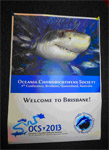 Oceania Chondrichtyan Society Meeting, Brisbane 2013. >>>
Oceania Chondrichtyan Society Meeting, Brisbane 2013. >>>
 Organizing a Manta Ray Symposium, Oceanography-2013 Conference >>>
Organizing a Manta Ray Symposium, Oceanography-2013 Conference >>>
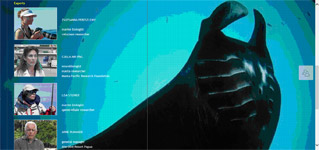
Our manta researcher is featured in The Giants of the Oceans movie >>>
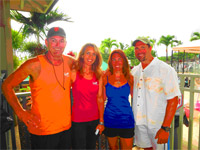 Partnering with the Manta Pacific Research Foundation 2013. >>>
Partnering with the Manta Pacific Research Foundation 2013. >>>
Manta Research at the Bahamas, Atlantis Aquarium
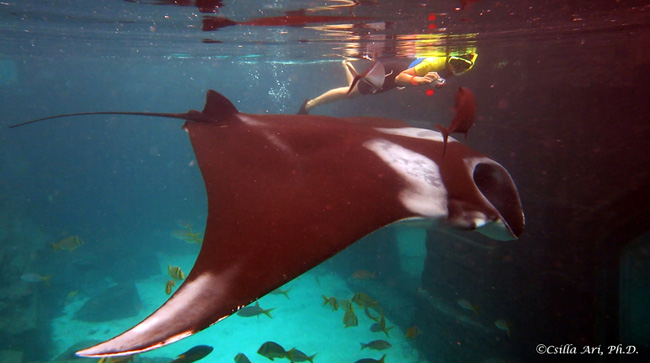
In 2011 Dr. Csilla Ari received a grant from the Save Our Seas Foundation to perform studies on the sensory, learning abilities, cognitive and social behavior of giant manta rays on captive specimens at the Atlantis Aquarium.
Dr. Ari`s previous research revealed that manta rays have the largest brain of all fish studied so far. Her study was published in the Open Anatomy Journal in 2011 and is available for free to the public: http://www.benthamscience.com/open/toanatj/articles/V003/1TOANATJ.pdf
`I did my PhD on the neuroanatomy of different shark and ray species, so I compared the brain structure and histology of several different cartilaginous fish species. The brain of mantas and mobulas were outstanding. To date nobody knows for certain why they need such large brain. I have been interested in manta rays since I was 13 years old, but after studying their brain I became even more keen to find out more about their abilities and social behavior.`-talks Csilla about the beginnings.
The Save Our Seas funded project mainly focuses on finding out more about the visual abilities, social behaviour, learning and memory of giant manta rays (Manta birostris) with the largest brain of all fish.
Why it is important
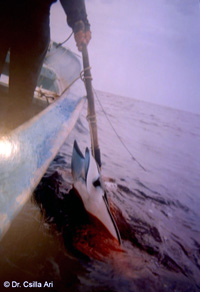 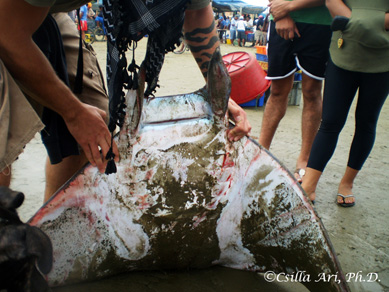
Manta and Mobula populations are heavily fished in many countries, they are listed as vulnerable and near threatened on the IUCD Red List, while we still know only a very few things about them. They are difficult to study in their natural habitat because their presence is often unpredictable, an experiment conducted in the wild is often expensive, and it is hard to create a well-controlled environment.
Dr. Ari published the first scientific paper on a behavioral experiment conducted on a giant manta ray (Manta birostris) in the Lisbon Aquarium, which revealed some interesting information about the importance of vision in the life of manta rays. 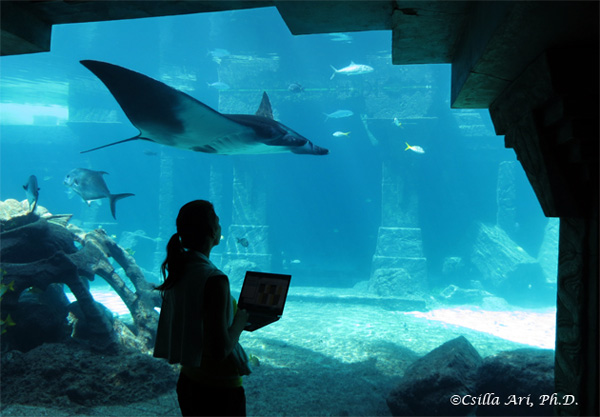
`The curiosity and interest of these animals toward humans, as well as the results of the preliminary experiments on wild manta rays in the Maldives and Ecuador have inspired me to conduct more detailed experiments in a well-controlled environment. I have been in contact with the Atlantis Aquarium, Bahamas from 2005 in order to continue my experiments on the giant manta rays, which I started at the Lisbon Aquarium in 2004. I am very grateful for the Save Our Seas Foundation that made it possible to finally study the manta rays at the Atlantis Aquarium by providing funding.`
Experiments at the Atlantis Aquarium
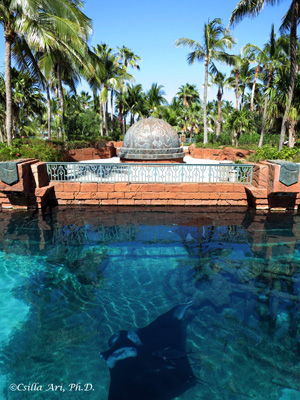 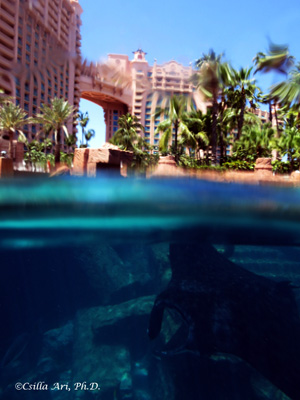
`During my study a new specimen was introduced to the tank, which specimen most likely belongs to a still undescribed, third manta ray species. She had some morphological characteristics that would imply she was a Manta birostris but other characteristics implied she was a Manta alfredi. It was a very exciting time to observe an animal which does not even have a proper scientific name yet.`
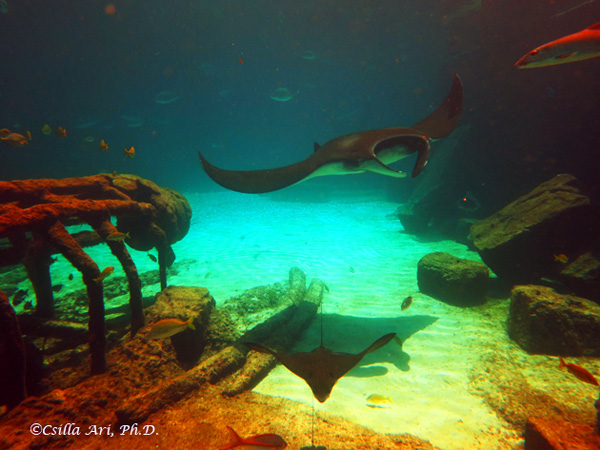
`One of my main goal during this project was to understand more about the visual abilities of manta rays and the importance of vision in their daily life, which could also help us to assess the impact of the presence of divers, boats, artificial objects in their natural habitat. A line avoidance test was designed to reveal their visual threshold until where they are able to detect floating lines, other tests to find out whether they could distinguish people and whether they respond differently to objects with different properties.
My other main goal was to find out more about their learning abilities which tells us how much they rely on previously learned experiences. This information helps us to predict whether they are able to follow daily/monthly routines, for example how efficiently they are able to memorize migratory routes, certain places or certain individuals.`
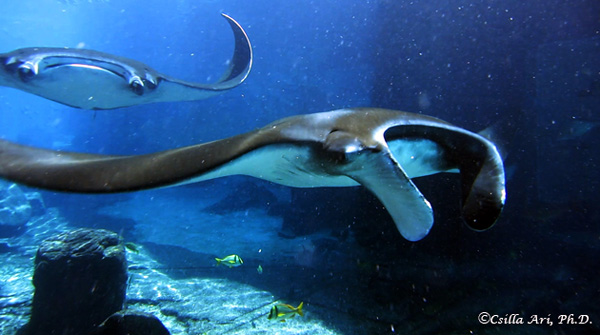
`Self-awareness is a very important adaptation, because it gives animals the ability to recognize their environment and themselves, therefore the `mirror test` was performed on the captive manta rays at first time, which resulted in a very interesting outcome, but could not be finished completely due to technical difficulties.
Brain anatomy and now behavioral observations of manta rays indicate that they are more social than solitary, many aspects of inter- and intraspecific communication has been documented and still being analysed, while even more question arise. Most of social animals that need each other in order to improve their survival also possess a strong emotional communication behavior, which was documented first time ever on manta rays.`

`During this project I managed to identify behavioral characteristics that will improve our understanding about their habits and lifestyle and therefore enable us to make their protection more successful. The collected data is still being analyzed and it will take a few months to go through and make sense all the behavioral observations. All these results will also significantly help the welfare of captive manta rays in aquariums worldwide. The results of the research will help public awareness and conservation initiatives worldwide through posters, presentations and scientific publications thanks to the Save Our Seas Foundation. I am very excited to continue this type of research, I believe there is a lot to learn about and from these animals.`-summarizes Dr. Ari the progress made at the Atlantis Aquarium.
Her blog posts are available on the Save Our Seas Foundation website.
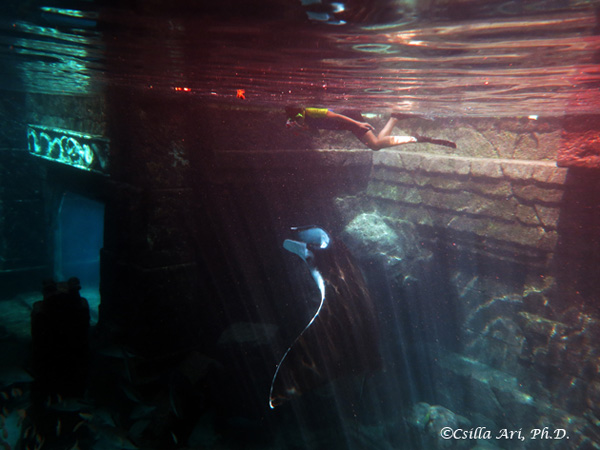
Dr. Csilla Ari has recently published the first scientific paper on the comparative neuroanatomy of devil ray brains. The paper reveals interesting descriptions of manta ray brains, including that they possess the largest brain among cartilaginous fishes, as well as of all fish species studied so far.
Encephalization and Brain Organization of Mobulid Rays
(Myliobatiformes, Elasmobranchii) with Ecological Perspectives

Dr. Ari has just returned from the Atlantis Aquarium, Bahamas, where she conducted new behavioral experiments on the sensory, cognitive abilities and social behavior of manta rays that were sponsored by the Save Our Seas Foundation. During her work she had a chance to study the yet undescribed, third manta ray species. Exciting stories will come soon!
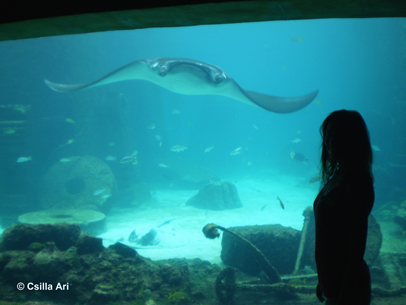
Ecuadorian Manta Research Expedition


Dr. Csilla Ari diving with a giant manta ray Rio Blanco rainforest
September of 2010.
Mark Harding, Save our Seas project leader, field researcher and photographer, after traveling for many years to the small village at the Ecuadorian coast, Puerto Lopez, recognized the value of the giant manta rays for the local communities and the danger these wonderful animals were exposed to. He initiated a well-needed research on the Ecuadorian manta rays, creating an important data set during several years of scuba diving by the remote island, Isla de la Plata. As he contacted and invited Dr. Csilla Ari, the Foundation`s scientific director, to join his scientific and conservation efforts, Csilla soon headed to the remote Ecuadorian village to help and to find out more about this completely unknown population of this mysterious species.
After meeting with her friends, Anne-Marie Kitchen-Wheeler and Matt Kitchen in Quito, Csilla and her friends flu together to Manta, and they were soon on the curlicued dirt roads to reach their final destination, Puerto Lopez.
`The remote village made us appreciate even more what we have and what kind of circumstances we can live in at home. This was not the first time when I traveled to places where people live with very basic resources, but it certainly touched me what I found there and made me reevaluate my own life again.`- reported Csilla after two weeks she spent accommodating to the lifestyle of the locals.

 Puerto Lopez beach and main road
Puerto Lopez beach and main road
The next, cloudy morning the small research group geared up to visit Isla de la Plata which took about an hour boat ride.
Video: By Isla de la Plata
Video: Dive starts
The first dive offered unexpectedly challenging conditions for the divers. The current by the Island was so strong that some of the supporting divers refused to descend and the researchers had serious difficulties to even complete the dive safely, while making notes, running experiments were completely impossible.
` The first and the second giant manta ray I saw -both of them are about 5 meters wide-, were calmly swimming just a few meters under the anchor line where we tried to drag ourselves down in the deep against the current. But I quickly realized that I could not follow them with my eyes, since when I turned my head into another direction instead of facing the current, the current was about to tear the mask off my face. Half way down I had no more power to pull the gauge to the front to check the depth or my air supply while all my gear I had was flying around me trying to tear me off the line. Not too much to choose from…if I let the anchor line go I might end up to be a hammerhead shark bait by the time I surface somewhere who knows how far in this current and the boat would find me or I continue dragging down myself and hoping to get some rest on the leeside of the rocks close to the bottom.`-as Csilla explained the circumstances on their first dive.


After the first experiences they adjusted their gear to the challenging conditions and had to redesign how and what kind of research can be done in such strong current, poor visibility and freezing cold water under the thermocline.
`It was annoying that the manta rays were there, around us, we just had great difficulties to move where we wanted to, while they basically did not even notice the strong current.`-said Csilla. `But fortunately after a few days the current got weaker and we could start working more efficiently.`
Video: A day with less current
Mark started to identify the individuals around the Island a few years ago based on photographs taken of their unique ventral markings, which helps them to get an idea about how often the same individual comes back. The assessment of the size of the population and their migratory behavior will have important conservation implications. By measuring important environmental variables they are hoping to find a correlation between a certain parameter and the mantas` presence in order to predict their large-scale movement.
Videos: Manta approaching
Opening the cephalic fins
Manta ray being cleaned
`We also managed to complete some basic observations on their cleaning behavior, which is somewhat different from what we experienced on the other manta species, Manta alfredi in the Maldives.
Videos: Manta ray at cleaning station
Ticklish manta ray


Yellow butterfly fish cleaning the manta ray
Matt filming a manta ray
Video: Yellow butterfly fish gathering at the cleaning station
Video: Angelfish waiting for the next costumer at the cleaning station
Csilla, based on her background in neurosciences and her studies on shark and ray brains, was also very interested in finding out more about their sensory, learning abilities, inter- and intraspecific interactions and social behavior, which is a completely blank page. She is the first and only scientist in the world who conducted a scientific study on the sensory and learning abilities of giant manta rays on a captive individual and now she plans to expand the experiments on wild animals as well in the future.
Video: Manta ray and scuba bubbles
Next morning on the way to the dive boat the small group came across the fishermen returning from the sea with their nightly catch and witnessed the shocking shark landings…the income of the locals are heavily based on the fishing, as they sell the shark fins for the Chinese market, where shark fin soup is still an increasing demand. Most of the shark bodies in Ecuador are used for human food consumption, due to the poverty in the country it is still regarded as edible, and ends up in white fish products such as fish fingers of battered fish steaks.
Thresher sharks are the main target
Video: Thresher shark landing in Puerto Lopez
`A heart-breaking situation that is not easy to change…it needs to be changed but we have to give an alternative option for the locals who need income. To develop sufficient turism industry in the region will take more time…by that time it is probably late for the sharks.`- explained the situation Csilla.
Fortunately the manta rays and their smaller relatives, the Mobulas are safe in the region since the end of August: thanks to Mark`s and his colleagues` committed work the Ecuadorean Government has announced that it had outlawed with immediate effect the taking of any Manta birostris, Mobula japonica, M. thurstoni, M. munkiana and M. tarapacana. The new law prohibits any taking of these species from any form of fishing method including the landing of incidentally caught individuals, which if caught must be returned to the sea, alive or dead. It will take a little while for the law to take effect, even though actually the decline in the number of Mobulas caught was very fast. We, unfortunately still found a landed Mobula, which nobody claimed… Before the law 30 to 50 Mobulas were landed daily, so one is a very big improvement.


Landed Mobula
After a few days diving by Isla de la Plata Mark decided to introduce us to a new dive site, a seamount around 50 miles south of the Island, where fishermen reported to see manta rays near the surface.
`Based on GPS markings we jumped into the waves not knowing what to expect. On the first dive we just drifted at about 30 meters deep above the sandy and somewhere rocky seafloor and met only a surprised turtle and floating tunicates, probably we missed the top of the seamount just slightly. The second dive was the perfect place: a huge cleaning station where probably nobody dove before us…the cleaner fish came up trying to clean us as well making us wonder what else do they clean other than mantas that they would accept us too`- remembers Csilla. `We just waited in the middle of the cleaning station, while mantas were coming and going, it felt like a strange, underwater carwash station. They stopped to allow the tiny, bright yellow butterfly fish and angelfish to surround them and clean them from parasites and dead tissue and after a few seconds they left. `
Video: Mantas arriving at the cleaning station
`I was amazed how curious some of the manta rays were sometimes, they came back several times just looking at us, certainly not scared, most likely due to their large size. In contrast to the Maldivian manta rays, we did not see serious shark bites on these individuals, although hooks and fishing lines present danger for them in this area too.`


Hook and fishing line can cause serious injuries
Waiting at deco stop

 Manta with missing cephalic fin
Fishing line can cut off their cephalic fin
The group was lucky and could observe the rare color variation, the black manta: `The first black manta was like a dream, he came up from the deep blue like a graceful ghost, I tried to make eye contact, like I did with the regular chevron mantas, but I just could not see the eye, even if I was very close, everything was so dark on him. He was still very curious and surprisingly agile.`
Videos:
On the way back the boat was usually full of tired, sleeping passengers, until the crew spotted jumping humpback whales in the distant, dark waves. Puerto Lopez is mainly famous about whale watching.
Sometimes turtles surrounded the boat checking it out curiously.
Videos: Turtles
Since diving is not allowed 24 hours before flight allowing the nitrogen to eliminate from the divers blood-stream, the last day Anne-Marie and Csilla decided to go for horseback riding in the rainforest, Rio Blanco.
Video: The beginning of the rainforest adventures

 Sometimes better on the horses... ...sometimes better without horses `We expected a relaxing walk in the rainforest on the horses, but instead it turned out to be one of the most dangerous adventure of our trip. Coming down from the hill the slope was so steep that the horses were sliding down in the mud with us on their back. When they could not stop we got branches, huge palm leaves into our faces, tearing up our clothes, hair. Although it was continuously foggy rain high up in the clouds, we certainly did not feel cold and were relieved when we could finally stand on our own shaking legs again at the end of the trip.`
Video: Almost on the top
Video: Deep in the rainforest
Video: Pleasant walk
On the day leaving Puerto Lopez, Csilla could not miss the chance to examine the brain of a rare shark species while she saw they were passing by the fish processing stages and stopped the car. The fishermen covered with blood were standing there surprised between piles of huge thresher sharks and marlins while she got off the car in her nice white clothes with pretty earrings.
`I explained to the surprised fishermen with my poor Spanish why exactly I really want to see the brain of a thresher shark. They brought me two halves of thresher shark heads and pointed at the huge eye muscles, later at some other junk. After I convinced them those were not the brain and I really needed them to cut up the thick cartilage of the braincase, one of them followed my instructions and after finding the right angle his huge knife finally exposed the brain.`
By the time Csilla was digging out the brain from the bloody braincase with her bare hands, all the fishermen left their fish carcasses and gathered around watching and listening Csilla talking about what she saw on the brain and why it was interesting.

 Thresher shark brain
`Although at the beginning I was not sure whether I would make the fishermen angry or not with my strange request, but they were rather nice and very helpful. It was a pleasant feeling that I could show them something interesting in their fish that they really liked while I collected important information for my studies.`

Quito from above before the rebellion started `The way home turned out to be rather adventurous as well: After Anne-Marie and Matt left with an earlier flight, I got stuck in Quito, because the military and police turned against the Ecuadorian president and took over the airport, exactly when I was about to board on our plane.we got the news that our plane was delayed soon after they said it was cancelled. After collecting our luggages we had to leave the airport without getting any information on what was going on. I saw people fighting on the street on a TV at a bar before leaving the airport with my poor spanish and some help from strangers I figured this was all going on inside the airport. Protestants stopped an airplane on the runway. Now I started to see clearly why I saw some people in military uniform rushing the opposite direction on my way to collect my luggage. I was extremely lucky, because I met a lady, Martina in the line while waiting who was working for Novartis, this time at the Quito office, who`s Company took care of her in this unexpected situation. She was so generous and helpful to rescue me from the airport as well by that time the public transportation and taxi services collapsed, the shops, banks, offices were closed because there was no security, therefore no food shopping or money withdrawal were possible and we did not know how long this will last. Fortunately, we could have lunch at the Novartis office and since the situation just worsened-we were not supposed to go out on the streets, they announced political emergency situation-, the Novartis employees rescued us to the safe Sheraton hotel, where we could follow on TV how the president was attacked. Later we watched the TV astonished how people attempted to kill the president at the hospital, people fighting and dying on the streets and taking over the TV studio as well. Next morning I woke up at 5:30 thinking that I heard an airplane either I was hallucinating or they opened up the airport the airport telephone number they gave me did not answer and the Miami flight was still officially cancelled. Very soon Martina got a phone call from her friends that we should rush to the airport immediately, they put us on a list to get on a plane, even if the flight was officially cancelled. Front of the airport entrance a few patches of blood reminded me that I should really get out of there. After check in we had only 10 minutes left and we were sitting on the airplane. Long minutes passed after half an hour delay the pilot reassured us we were about to finish security checks and we finally took off. I am extremely grateful for Martina and the Novartis company for their generous and immediate help in every sense I needed in this difficult situation and I am happy to get to know such a great group of people!
`I am very grateful for Mark Harding to involve me in this important and exciting project, he can always count on my help for his research in the future!'

 `I am very grateful for the support I got from Anne-Marie and Matt during diving activities as well as during the whole trip!`
`The balance of this trip is definitely positive: life-time dreams coming true, important scientific steps taken forward, unforgettable moments with magnificent underwater creatures, creating new friendships with great people and only a few unexpected troubles and only one broken bone (unfortunately:-( ). I am back to my normal life and official work, but I will dedicate time in the next few months and I will start working on building up new projects for the future to get to know more about the south pacific giant manta ray population passing by the remote Ecuadorian coast that now feels like is the end of the world.`
Dr. Csilla Ari`s book on shark and ray brains available on the Amazon:
December of 2009
|
